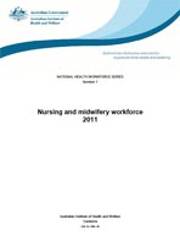Summary
This report presents information on the nursing and midwifery workforce, based primarily on estimates derived from the National Health Workforce Data Set: nurses and midwives 2011, the first in this new series. The data set contains information on the demographic and employment characteristics of nurses and midwives who were registered in Australia in 2011. Data are collected via registration forms and a survey instrument administered by the Australian Health Practitioner Regulation Agency, in conjunction with the annual registration renewal process for nurses and midwives.
The main findings of the report are:
Size of nursing and midwifery workforce
- In 2011, the total number of nurses and midwives registered in Australia was 326,669, a 6.8% increase since 2007 (305,834).
- Between 2007 and 2011, the number of nurses and midwives employed in nursing or midwifery increased by 7.7% from 263,331 (86.1% of registrations) to 283,577 (86.8% of registrations).
- Of these people employed in nursing and midwifery, 36,074 were midwives (including 1,517 people registered as midwives but not nurses), though only 15,523 reported working in midwifery as the principal area of their main job.
- Overall, nursing and midwifery supply decreased by 1.3% between 2007 and 2011, from 1,095.1 to 1,081.1 full-time equivalent nurses and midwives per 100,000 population, based on a 38-hour week. This was mainly a result of a 7.4% decrease in the number of employed enrolled nurses and a 1.6% decrease in the average hours worked by all nurses and midwives over this period.
- Nursing and midwifery supply across regions ranged from 1,101.6 full-time equivalent nurses and midwives per 100,000 population in Major cities to 994.7 in Outer regional areas to 1,335.5 in Very remote areas, based on a 38-hour week.
Demography
- Nursing and midwifery continued to be a female-dominated profession, with women comprising 90.1% of employed nurses and midwives in 2011 (down from 90.4% in 2007).
- The average age of the nursing and midwifery workforce increased between 2007 and 2011 (from 43.7 to 44.5 years). The proportion of nurses and midwives aged 50 or older increased from 33.0% to 38.6% over this period.
Working arrangements
- The average weekly hours worked by employed nurses and midwives decreased from 33.3 hours in 2007 to 32.8 hours in 2011.
- Of all employed clinical nurses and midwives, almost two-thirds (65.2%) worked in hospitals.
- Almost two-thirds of all nurses and midwives reported working in the public sector (59.3%), and these nurses and midwives worked an average of 2.4 hours more per week than their private sector counterparts.
- The clinical area of nursing and midwifery with the largest number of workers in 2011 was aged care (40,443), which also had the highest proportion of enrolled nurses (41.5%).



